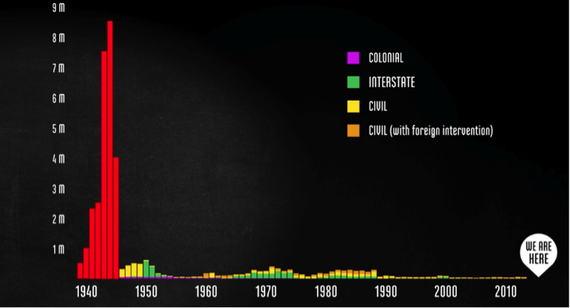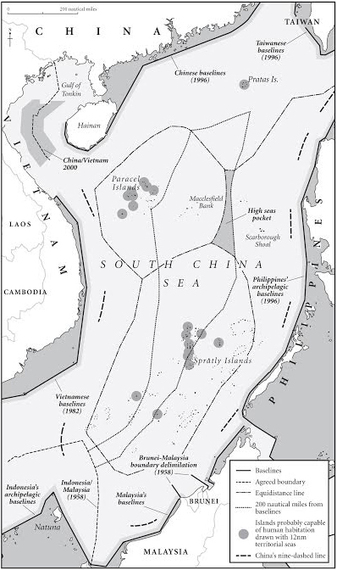The South China Sea might be a marginal sea in strictly geographic terms, but based on its history and present importance in international trade, it is central to defining the most consequential bilateral relationship in the world - that of China and the US. Is the US ready for China to become a strategic as well as commercial player in global affairs?
It is impossible to ignore the rapid rise of China as a superpower, in keeping with its relative size, over the past three and a half decades. It has flourished economically and risen politically on the world stage, resulting in seismic trading shifts and sometimes tensions between its neighbors in Asia and the United States. The South China Sea has played a role in dramatizing these conflicts. However we cannot allow swashbuckling antics and bellicosity by any nation to bring to an end a 70-year era of peace, prosperity, and international integration.
It is an amazing fact that there has not been a war between major powers since World War II. What we do not appreciate is that in spite of current conflicts in the Middle East and elsewhere, we are actually enjoying an extended period of peace that is unprecedented in modern human history. A stunning visualization by Neil Halloran The Fallen of World War II underscores our current great good fortune, not seen since the days of the Roman Empire.

The tall red bars indicate the number of fatalities for each year of World War II, a total of 70 million people worldwide. The steep decline since that time is perhaps a dividend of the dawn of the nuclear age that forced state actors to remain rational. Can we depend upon them to remain so? Can we imagine a war between major nations that does not invoke the nuclear option?
I bring this up in connection with the current situation in the South China Sea, because I am worried about a sense of inevitability setting in, an easy fatalism that allows us to think that war between great powers such as China and the US is unavoidable. Acceptance of this premise could make leaders on either side careless and unpredictable.
China policy expert Bonnie Glaser at the Council on Foreign Relations perceives danger. "Strategic warning signals that indicate heightened risk of conflict include political decisions and statements by senior officials, official and unofficial media reports, and logistical changes and equipment modifications." She recommends several courses of action, including the ratification by the US of the United Nations Convention on the Law of the Sea (UNCLOS). I was surprised to hear this hadn't already happened. Failure to join in this type of multinational framework does unfortunately make the US appear as if it wants to play by its own rules, in this case because we do not agree about the oversight of seabed mineral rights.
China is also failing to engage with multilateral institutions. This month the UN Tribunal in The Hague will hear arguments from the Philippines about their territorial claims in the South China Sea. China has decided against participating in the arbitration process. This is a shame, because the Tribunal's decision will likely be a landmark in the history of the law of the sea. Whatever the outcome, discussions about Zhou Enlai's 9-dashed line that delineates China's territorial claims in the South China Sea will certainly be at the fore when the Philippines hosts APEC this coming November. Since the US has a mutual defense treaty with the Philippines, the US will be involved in the outcome.

The South China Sea - known as the East Sea in Vietnam and the West Philippine Sea in the Philippines
As shown in this map of the South China Sea, the task of untangling a knot of nautical boundaries, Exclusive Economic Zones, agreed boundaries, and China's 9-dashed lines might seem an impossible task. However, Bill Hayton's pithy, erudite, and intense account of its history, The South China Sea: The Struggle for Power in Asia is up to the task. Although a journalist himself, Hayton sails past the usual media drumbeats and simplifications, beginning with the surprising early history of this marginal sea that is part of the Pacific Ocean. I found it amusing to learn that the South China Sea, now the tug toy of large nations, has islands that were originally inhabited by ancient peoples who wished to escape the clutches of the state.
Hayton describes the archeology behind the claim that the original islanders were stateless, followed by India's growing influence in the region before the colonial powers came to Asia. A Hindu-based system of government prevailed, with very fuzzy borders:
Kingdoms referred to themselves by the Sanskrit term mandala-wheel- and the rulers as cakravartin-wheel turner. They saw themselves as centers of networks, rather than states with defined borders. Their legitimacy came less from physical control over territory and more from recognition by other rulers.
The ecosystem of the South China Sea was defined by fluidity, and by pirates. Its importance to global trade from ancient times to currently $5.3 trillion of shipments passing through its waters per annum (including half the world's oil) is beyond dispute. In addition to territorial and boundary claims, what is new is the idea of creating islands where they did not exist. But according to Hayton, the Chinese have actually been building artificial land features since at least 1987, when scientific expeditions were encouraged.
Fiery Cross Reef would not have been anyone's first choice for a research station. At high water it was almost entirely submerged, except for a single meter-high rock at its southwestern end. The rest was composed of a ring of sharp coral, 25 kilometers long and 7 kilometers wide. The main reason it wasn't already occupied was that there was almost nothing there to occupy. But that did not deter Liu's (Admiral Liu Huaqing) navy. On 21 January 1988 four Chinese ships arrived with engineers and construction materials and set about creating something that could resemble dry land.
The Vietnamese acted on this incursion into the Spratly Islands by China. It did not end well - and a number of Vietnamese were killed, as Hayton mentions the engagement is shown in this official Chinese video. Hayton explains at least part of the Chinese impetus behind these territorial claims, the history of its invasion by Europe. "The main reason for the sensitivity about borders and sovereignty in the region is, of course, the experience of China during the period its ideologues call the century of humiliation". His telling of the history of the region creates a layered understanding of current conflicts and the potential for a larger war.
The South China Sea ends with an endearing admission by the author-his conclusion differed from what he set out to prove.
I started writing this book because I believed, like many other people, that some kind of conflict in or around the South China Sea was imminent. In the very last phase of my research I changed my mind. I became convinced that the Chinese leadership understands that it can only lose from a shooting war, although it views everything short of war as a useful policy tool. I expect that, from time to time over the coming decades, low-level confrontation will escalate into periods of diplomatic and military crisis and perhaps even superpower confrontation.
The history of the South China Sea is complicated. If military conflict disrupts its trade flows, the effect on the world economy would be distressingly negative. If disputes result in conflict between the US and China, we can probably not even imagine the devastation that storm would cause the world. The real interests of the US and China are so intertwined, they are in many ways inseparable. Hopefully, politicians on both sides will steer clear of disaster.
This article first appeared on the Yale University Book Blog http://yalebooksblog.co.uk/2015/07/06/the-south-china-sea-a-review-by-lyric-hughes-hale/